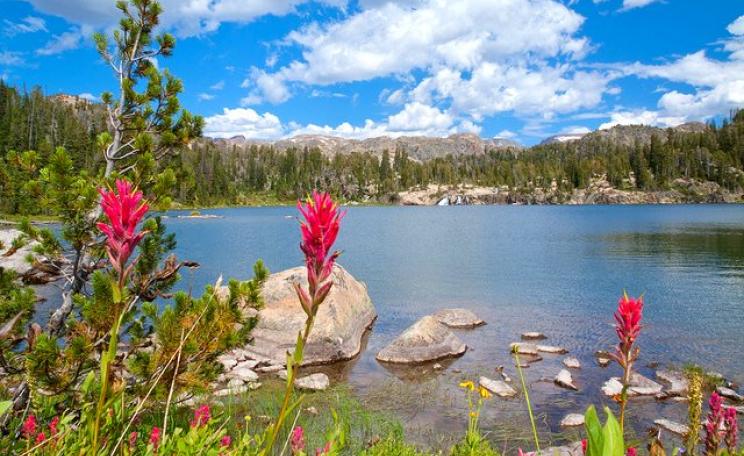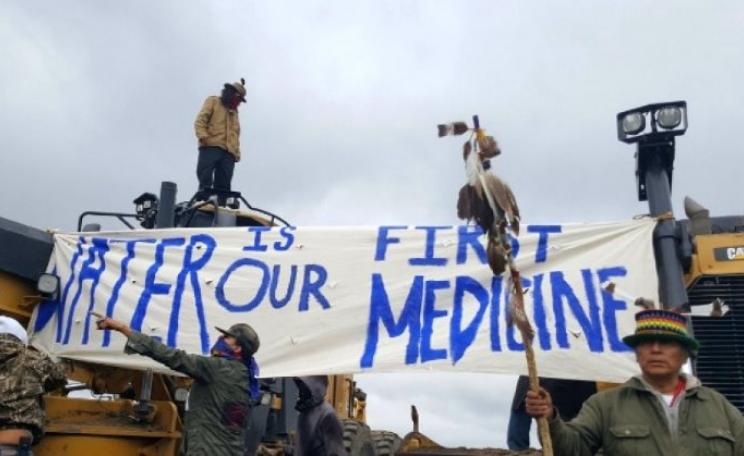Chevron is a fugitive from justice. The company has been convicted three times under Ecuadorian law and is still using its tricks to evade justice ... How long will we keep fighting? We'll fight until they pay for and repair the damage.
When Servio Curipoma built his house in a small plot of land in the Ecuadorian Amazon, he did not know that a pool of oil lay underneath.
This was one of the nearly one thousand pools Texaco dug for waste disposal from its oil extraction activities, which it then covered again with soil to hide it from sight.
Twenty years later, in 2008, Servio and his family were relocated in a new house, some 20 meters away. By then, both his parents had died of cancer.
The rural parish of San Carlos, in the Amazonian province of Orellana, is located in the Sacha oil field, one of the largest in Ecuador. Discovered in 1969 by the US transnational company Texaco, it was bought by Chevron in 2001. In Sacha well no. 56 you can still see the remnants of its infrastructure and of the foundations of the house the Curipoma family left behind.
Ermel Chávez, leader of the Front for the Defence of the Amazon, points to the land where Servio grew his bananas. "If you put a stick in here, for example, water and oil come out. The is oil is just covered up. Nobody knows the diameter, but they always built large pools, up to three metres deep and 30 metres in diameter."
Oil waste just dumped in situ
Texaco operated in the north-western Ecuadorian Amazon between 1964 and 1990. Each time the company drilled a well, it used the same technique. It dug large trenches - pools - in the ground around the platform, into which it discharged the initial oil extraction, sludge from the drilling process, and any waste water - without any attempt at waterproofing or concern for the environment.
At the time, these practices were already considered obsolete and were even forbidden in some countries such as the US. Many of these pits were later covered with earth and hidden by the company, which never bothered to determine the exact number of pools constructed.
During the class action taken by 30,000 affected people against Chevron-Texaco, the plaintiffs filed 996 separate complaints. Four decades later, the pools continue to leak toxic substances into the ground and to contaminate the groundwater.
Carmen Morocho lives with her family only a few metres away. Her house was built over an oil spill that occurred 40 years ago. "We are living on the spill. Everything is polluted, and we are also. Even inside the house, on the ground, there is a sheet of dried oil. We have covered it but ... "
She pauses, thoughtfully, as if to find a proper end to her sentence. "This is how we get to live", she sighs. And almost with the same resignation she explains that the land cannot be cultivated, because it produces nothing at all. "We haven't left, because it's hard for us to build a new house."
Chevron is a fugitive from justice. The company has been convicted three times under Ecuadorian law and is still using its tricks to evade justice ... How long will we keep fighting? We'll fight until they pay for and repair the damage.
Over 20 years of struggle
We leave Sacha for the Shushufindi field, in the neighbouring province of Sucumbíos. Along the way, the traffic of heavy trucks from the oil industry and countless signs of "danger" clash with the apparent peacefulness of the landscape.
The continuing presence of the Transecuadorian Pipeline System (SOTE), a network of rusty pipes that covers 503 km between the Amazon jungle and the Pacific coast, reminds us that we are in the quintessential oil zone in Ecuador. A large Government sign underwrites this:
"Oil promotes the Good Life in your community!"
During the trip, Ermel tells us about the process of community resistance. On November 3, 1993, a group of native people and settlers affected by the impact of Texaco activities brought before a court in New York a lawsuit on behalf of the 30,000 people affected.
A few months later, on May 15, 1994, the Front for the Defence of the Amazon was formed to pursue the suit and offer support and advice to the communities involved in the oil conflict. The organization later expanded through the founding of the Assembly of People Affected by Texaco.
Thus began a long process that has lasted over twenty years, which has united five native nationalities and farmers with a common cause: to demand justice, and social and environmental reparation.
Victory! Of a sort ...
On February 14, 2011, following the transfer of the trial to Ecuador at the request of Chevron, the Ecuadorian courts ordered the company to pay $9.5 billion dollars and to offer a public apology for the damage caused - failing which, the compensation would increase to $19 billion. The ruling was upheld twice: in January 2012 and in November 2013.
In the end, the damages were set at 9.5 billion dollars to be used for social and environmental reparation, depsite the fact that the company never apologized. It was the largest compensation ever imposed in the wake of an environmental dispute, and one that Chevron refuses to accept.
"The case has been won. Chevron has been convicted. Now the problem is to collect the money", says Ermel. Since the company has no assets in Ecuador, the only possibility is to arrange for property in other countries to be seized.
In November 2012 Argentina ordered the seizure of all the Chevron assets in the country, in what appeared to be the beginning of the enforcement of the sentence. However, the multi-million agreement between the renationalised Argentinian oil company YPF and Chevron for the exploitation of unconventional hydrocarbons in Patagonia, ended that possibility.
Now expectations have turned to Brazil and Canada. But it will not be easy. In March 2014, a judge in New York ruled that the Chevron conviction was "fraudulent". This ruling does not overturn the decision of the Ecuadorian courts, but encourages courts in other countries not to enforce the penalty.
On October 24, the affected community filed a request before the International Criminal Court in The Hague against Chevron's CEO John Watson and other senior executives of the company to be tried for crimes against humanity.
Recognizing the damage caused
Julia Gonzalez lives in Shushufindi since the years when Texaco operated in the area. She recalls sadly that they drilled a well right in front of the family home but nobody warned about the dangers involved.
The company carelessly dumped the waste and polluted the water sources that Julia and her family used for their daily consumption. "The water was yellowish and we washed and bathed in it, and drank it. We were never told that the water couldn't be used."
A study published by the Hegoa-UPV / EHU Institute concluded that lack of information on the harmful effects of the oil industry was widespread. It also revealed that on numerous occasions Texaco personnel told the population that "both oil and extraction water had positive effects on crops and even on the skin and general health."
"It eventually hit me and my family", Julia adds. Over the years they began to suffer from infections and diseases. All of Julia's family died of cancer. In areas particularly affected by oil pollution such as Sucumbíos and Orellana, cancer is the leading cause of death and its incidence is three times higher than the national average.
Health problems persist for the affected populations. "Each of us can feel it in our bodies, in our daily lives, in our health problems", says Julia. Fully aware that the social and environmental restitution in not easy, she demands that the company should admit to the damage done:
"We all want to put an end to this, but they should acknowledge the pollution and the harm inflicted on the population. They must recognize it so that we can finish with it all. This is my request."
An urgent solution
The Shushufindi 61 well, drilled by Texaco in the seventies, is still functioning. Today it is operated by the state-owned company Petroamazonas, which now undertakes the extraction work. Ermel leads us through a path to an uncovered pool. Through the vegetation, we glimpse of a lake of black oil. With a long branch to probe its depth. About three metres.
"The problem is that oil seeps through the soil into the water table. This pool is about 40 years old and the oil has been seeping all the time", he says.
Eight-five thousand samples of water and soil from different fields were taken during the legal proceedings. They all showed high levels of pollution. A study on the food chain showed that the fat from fish in the area contains hydrocarbons.
"We can deduce that the banana, cocoa, livestock and even the food is contaminated. The damage is incalculable", Ermel continues. He believes that for some issues there is no redress.
"How can you repair two indigenous villages which have disappeared? And what about the territories of the native peoples? And the lives of the dead?" These are some of the questions to which he tries unsuccessfully to find answers.
'Chevron is a fugitive from justice'
The last stretch of the route leads to the Aguarico 4 well, without doubt the most emblematic case. During the trial, the company lawyer claimed that the companies which have continued operating the wells after the departure of Texaco could be responsible for the pollution. This well, however, was operated exclusively by the US oil company.
Walking through a primary forest, we arrive at a new outdoor pool. A viscous mantle of oil covers its entire surface. Ermel thrusts in his hand and the white glove he is wearing comes out completely covered in crude. A strong smell of oil fills the air.
At one end of the pool, there is a pipe leading to a stream that runs downhill. This system, called gooseneck, was used by Texaco to dump polluted extraction water and sludge directly into creeks and rivers. The river water, which was once crystal clear, is today carries downstream a thick oily stain.
Ermel has been showning us along the way the still visible scars that the US oil company has left behind in Ecuador. What he does not understand is why other countries establish agreements with a company that refuses to admit its responsibility:
"Chevron is a fugitive from justice. The company has been convicted three times under Ecuadorian law and is still using its tricks to evade justice. When we go to Europe we always say that countries cannot do business with a company that is criminal. How long will we keep fighting? We'll fight until they pay for and repair the damage."
63,000 million litres of toxic water discharged into rivers, 680,000 spilled barrels of oil, 30,000 affected persons, two vanished indigenous villages and a million hectares of deforested land. This is the legacy which, after 26 years of operation, Chevron-Texaco has left in Ecuador.
Orlan Cazorla is a journalist from the Canary Islands who specializes in Latin America. He collaborates with media in Ecuador, Peru, Chile, Argentina and Spain. He currently lives in Ecuador, standing for the (ultra) peripheries. Web: www.orlancazorla.net
Miriam Gartor is a social, environmental and feminist researcher. As an independent consultant, sometimes also a photographer, she collaborates with various media in Latin America and Spain. Web: www.miriamgartor.com
This article was originally published by Lalineadefuego, Ecuador, and republished by openDemocracy under a Creative Commons Attribution-NonCommercial 4.0 International licence, also in a Spanish version.





